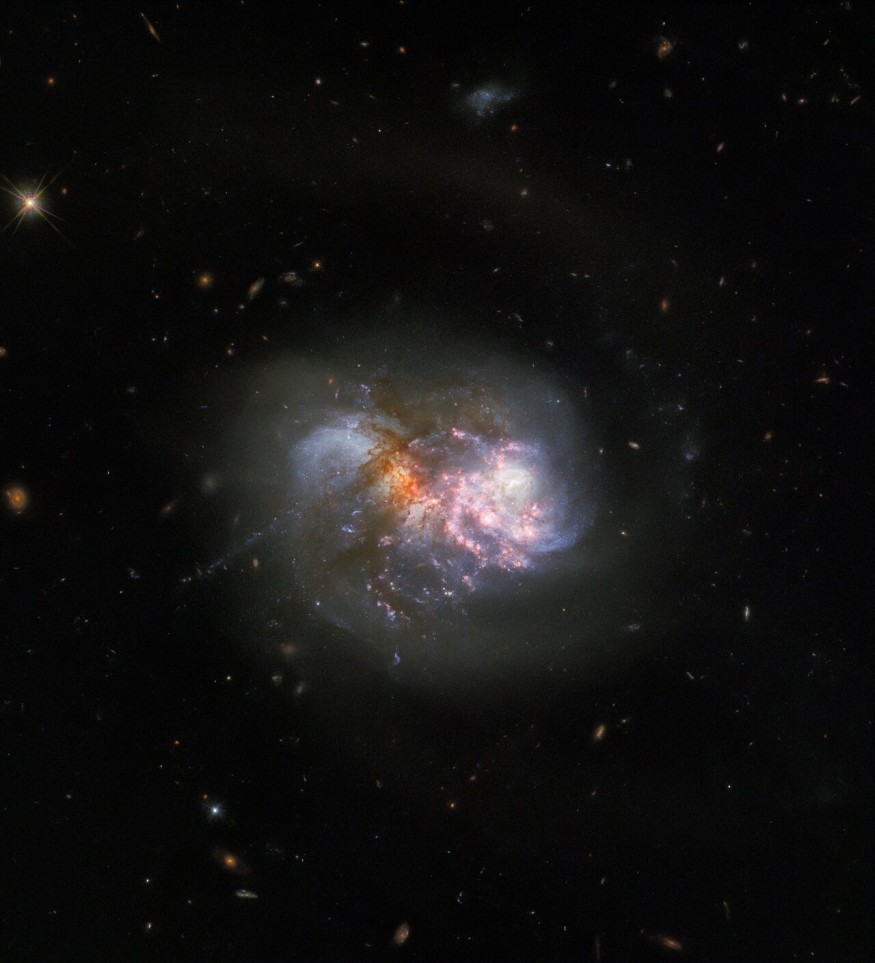The Hubble Space Telescope has photographed a devastating cosmic collision between the interacting galaxy pair IC 1623 in the constellation Cetus, which is about 275 million light-years away (The Whale).
According to astronomers, the merger could lead to a star-forming boom and a compact starburst galaxy construction. The European Space Agency (ESA) released the photograph on Monday, describing it as a "clash of the titans."
The merge was initially noticed in 2008, when Hubble peered into the system and noticed that the violent influx of gas would cause strong star activity, perhaps raising the system's brightness above ultra-light levels. Hubble captured optical and infrared wavelengths with the onboard Advanced Sounding Camera, which were subsequently processed to produce the final image.

New Data From the Wide Field Camera 3
This new image, according to ESA, integrates additional data from the Wide Field Camera 3. It combined observations obtained in eight bands ranging from infrared to ultraviolet to expose the IC 1623's finer characteristics.
A large amount of heated and dense gas exists in one of the two galaxies in the IC 1623 system. This type of gas can also be found in the overlap zone between the two nuclei.
The duo is nearing the end of their merger, when a furious center input of gas would cause severe starburst activity, perhaps pushing the infrared luminosity above the ultra-luminous threshold.
"Future observations of the galaxy pair with the NASA/ESA/CASA James Webb Space Telescope will shed more light on the processes powering extreme star formation in environments such as IC 1623," astronomers said in a statement per SciNews.
Prior Knowledge
Harpan Rakyat, an Indonesian news outlet, said astronomers detected a spiral galaxy around 13 million light-years from Earth before they found Galaxy IC 1623.
However, the galaxy is obscured by dense layers of cosmic gas and stars, making it difficult to see.
Scientists are tasked with using the Hubble space telescope to unveil the image. The findings reveal hidden galaxies.
Even yet, these observations resulted in a magnificent photograph of a galaxy's brilliant core. It emerges from the whirlpool of colorful cosmic clouds.
In addition to observations of Galaxy IC 1623, observations of the spiral galaxy IC 342 in the constellation Camelopardalis, roughly 8.9 million light-years away, have been made. It can also be found in NGC 2685 or Arp 336, a helical galaxy.
During the evolution of galaxies, colliding galaxies are common. The encounter is an example of galactic interaction. As a result, it lacks the propulsion to continue on its voyage after the impact.
In general, if one of the galaxies collides with a larger one, most galaxies will survive the merger intact.
Computer models based on genuine physics concepts will be used to simulate such collisions. The relative migration of galaxy pairs will be slowed by dynamic friction.
Hubble's Role In Detecting Cosmos
The Hubble telescope, which has been a window into the expanse of the cosmos, has undergone maintenance and repair work after the onboard computer failed. The payload computer is in charge of controlling and coordinating the scientific instruments on board the ship. Its failure has resulted in the suspension of scientific operations set up securely.
Future studies by the James Webb Telescope, which is due to launch later this year, are expected to provide fresh data about the distant galaxy and star formation as it occurs.
RELATED ARTICLE: Hubble Space Telescope Back Online: Captures Abel 78 in Constellation Cygnus Despite Glitch
Check out more news and information on Space on Science Times.












